cruise control Mercury Villager 2000 Owner's Manuals
[x] Cancel search | Manufacturer: MERCURY, Model Year: 2000, Model line: Villager, Model: Mercury Villager 2000Pages: 256, PDF Size: 2.21 MB
Page 6 of 256
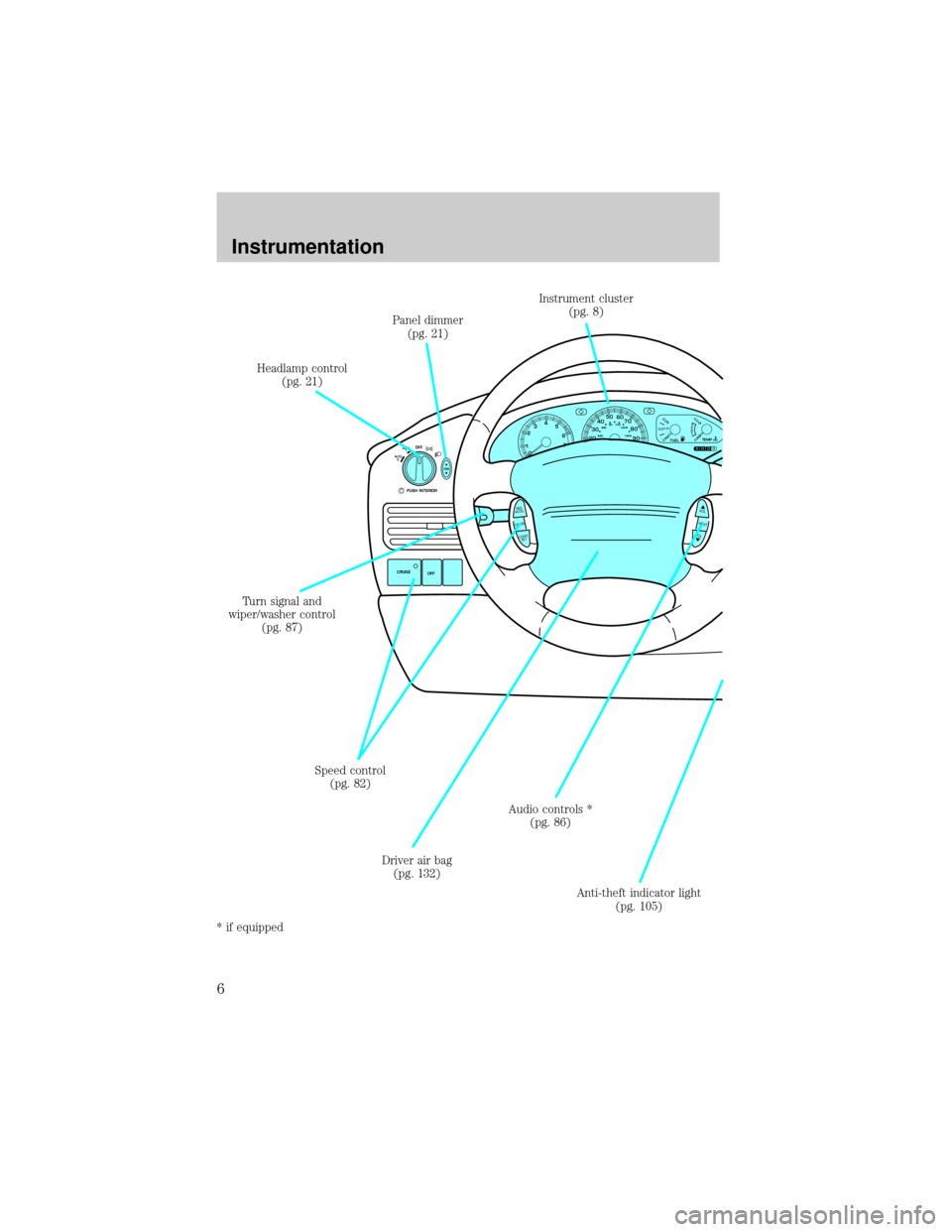
OFFAUTO
1
AUTO
2
PUSH INTERIOR
CEF
H1/2FUELTEMP
NORMAL000020304050
60
70
80
90406080100120
140
0 234
5
6
71
CRUISE
OFF
CANCELRES
ACCEL
COAST
SETVOL
NEXT
VOL
DIM
Panel dimmer
(pg. 21)
Headlamp control
(pg. 21)
Speed control
(pg. 82)
Driver air bag
(pg. 132) Turn signal and
wiper/washer control
(pg. 87)Instrument cluster
(pg. 8)
Audio controls *
(pg. 86)
Anti-theft indicator light
(pg. 105)
* if equipped
Instrumentation
6
Page 10 of 256
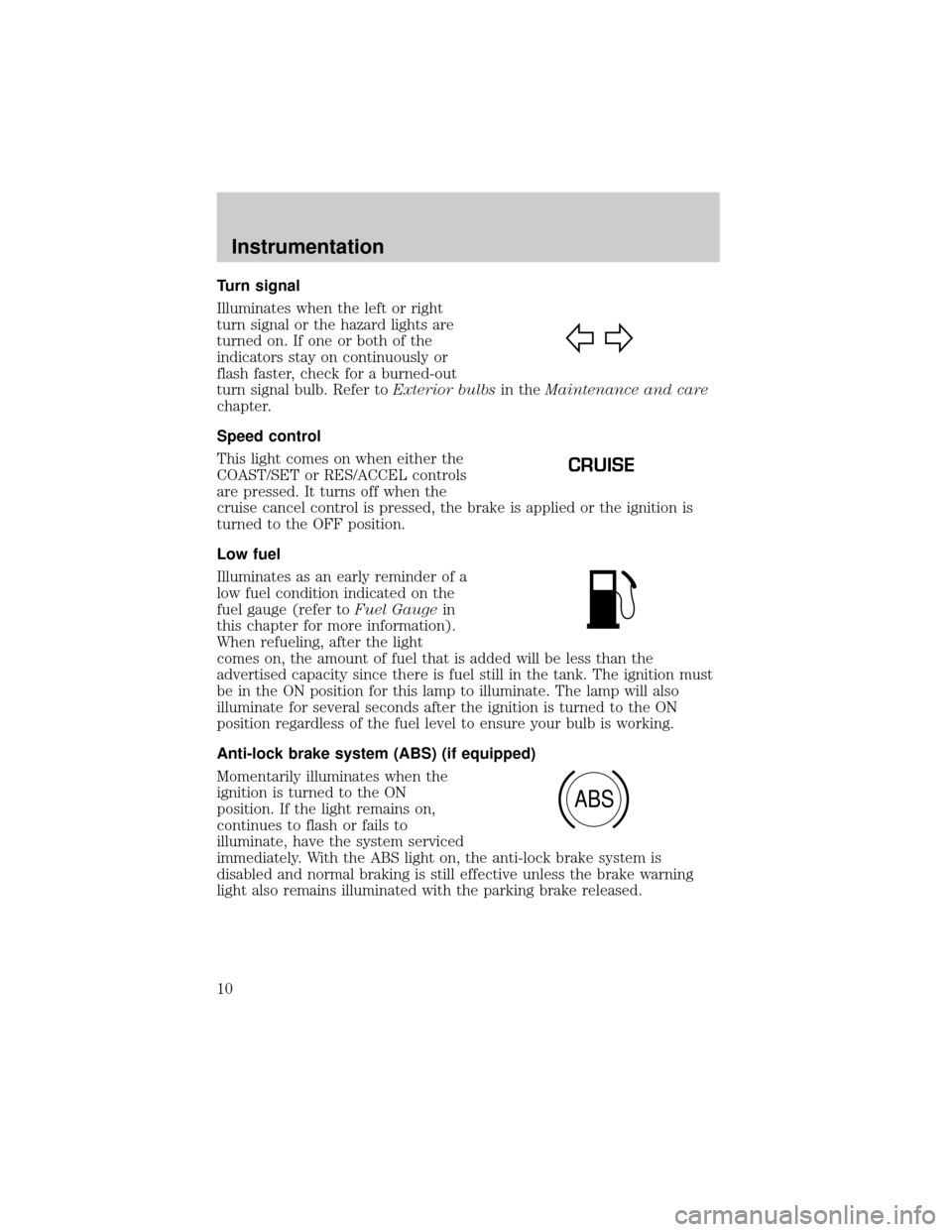
Turn signal
Illuminates when the left or right
turn signal or the hazard lights are
turned on. If one or both of the
indicators stay on continuously or
flash faster, check for a burned-out
turn signal bulb. Refer toExterior bulbsin theMaintenance and care
chapter.
Speed control
This light comes on when either the
COAST/SET or RES/ACCEL controls
are pressed. It turns off when the
cruise cancel control is pressed, the brake is applied or the ignition is
turned to the OFF position.
Low fuel
Illuminates as an early reminder of a
low fuel condition indicated on the
fuel gauge (refer toFuel Gaugein
this chapter for more information).
When refueling, after the light
comes on, the amount of fuel that is added will be less than the
advertised capacity since there is fuel still in the tank. The ignition must
be in the ON position for this lamp to illuminate. The lamp will also
illuminate for several seconds after the ignition is turned to the ON
position regardless of the fuel level to ensure your bulb is working.
Anti-lock brake system (ABS) (if equipped)
Momentarily illuminates when the
ignition is turned to the ON
position. If the light remains on,
continues to flash or fails to
illuminate, have the system serviced
immediately. With the ABS light on, the anti-lock brake system is
disabled and normal braking is still effective unless the brake warning
light also remains illuminated with the parking brake released.
CRUISE
ABS
Instrumentation
10
Page 15 of 256
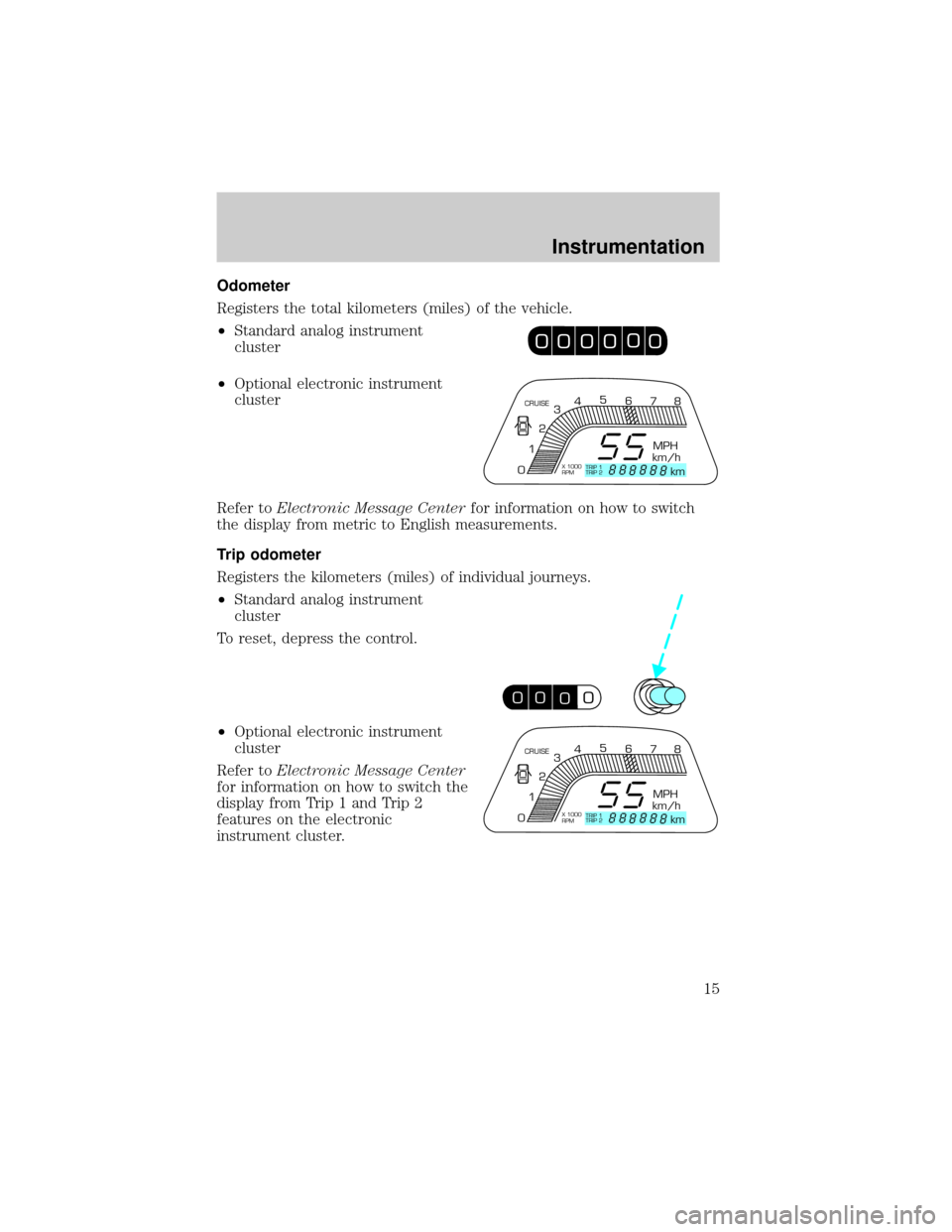
Odometer
Registers the total kilometers (miles) of the vehicle.
²Standard analog instrument
cluster
²Optional electronic instrument
cluster
Refer toElectronic Message Centerfor information on how to switch
the display from metric to English measurements.
Trip odometer
Registers the kilometers (miles) of individual journeys.
²Standard analog instrument
cluster
To reset, depress the control.
²Optional electronic instrument
cluster
Refer toElectronic Message Center
for information on how to switch the
display from Trip 1 and Trip 2
features on the electronic
instrument cluster.
0
00
00
000
000
0
CRUISE
MPH
km/h
km 012345
6
78
X 1000
RPMTRIP 1
TRIP 2
00
0000
00
CRUISE
MPH
km/h
km 012345
6
78
X 1000
RPMTRIP 1
TRIP 2
Instrumentation
15
Page 82 of 256
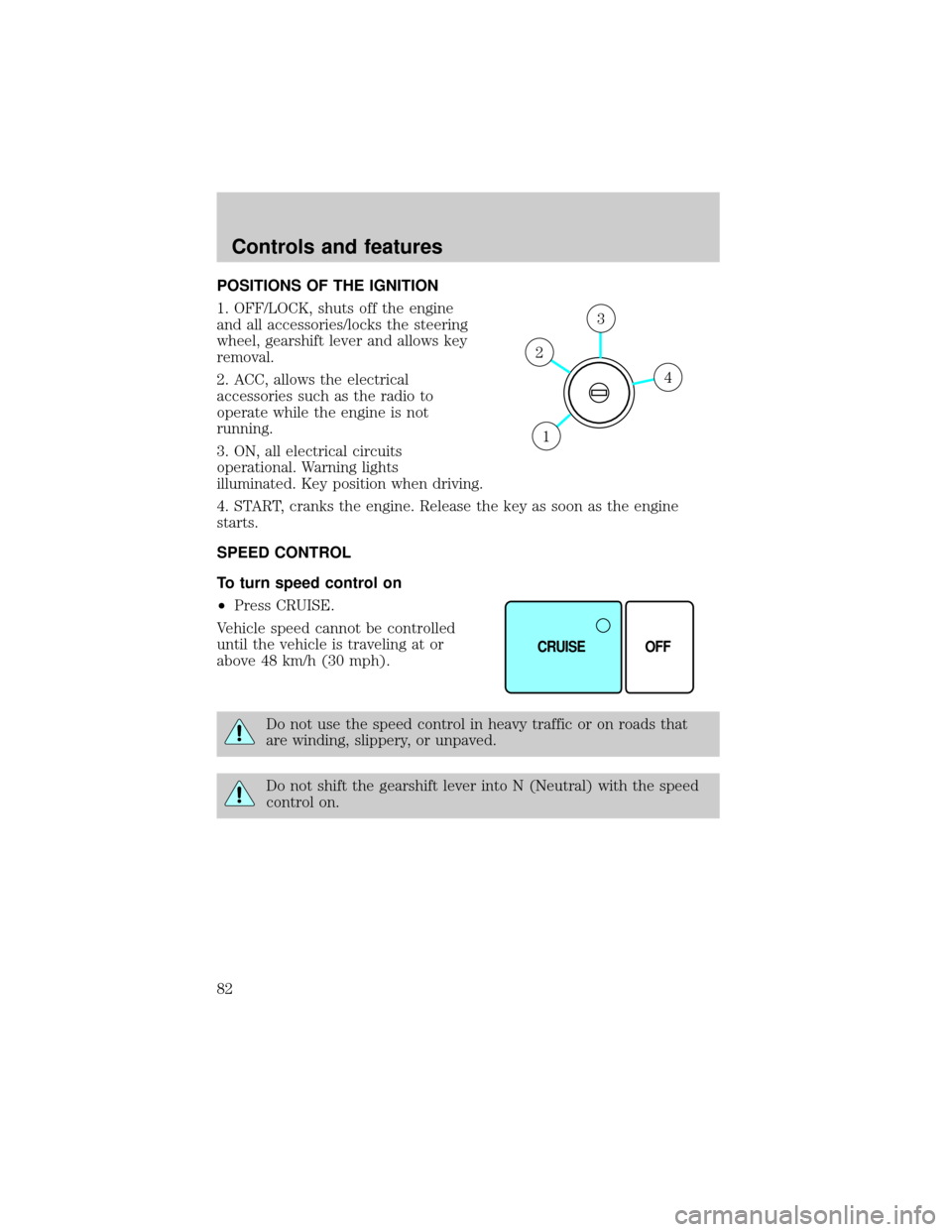
POSITIONS OF THE IGNITION
1. OFF/LOCK, shuts off the engine
and all accessories/locks the steering
wheel, gearshift lever and allows key
removal.
2. ACC, allows the electrical
accessories such as the radio to
operate while the engine is not
running.
3. ON, all electrical circuits
operational. Warning lights
illuminated. Key position when driving.
4. START, cranks the engine. Release the key as soon as the engine
starts.
SPEED CONTROL
To turn speed control on
²Press CRUISE.
Vehicle speed cannot be controlled
until the vehicle is traveling at or
above 48 km/h (30 mph).
Do not use the speed control in heavy traffic or on roads that
are winding, slippery, or unpaved.
Do not shift the gearshift lever into N (Neutral) with the speed
control on.
4
3
2
1
CRUISE OFF
Controls and features
82
Page 83 of 256

To turn speed control off
²Press OFF.
Once speed control is switched off, the previously programmed set speed
will be erased.
To set a speed
²Press COAST/SET. For speed
control to operate, the speed
control must be ON and the
vehicle speed must be greater
than 48 km/h (30 mph).
If you drive up or down a steep hill, your vehicle speed may vary
momentarily slower or faster than the set speed. This is normal.
Speed control cannot reduce the vehicle speed if it increases above the
set speed on a downhill. If your vehicle speed is faster than the set
speed while driving on a downhill, you may want to shift to the next
lower gear or apply the brakes to reduce your vehicle speed.
If your vehicle slows down more than 16 km/h (10 mph) below your set
speed on an uphill, your speed control will disengage. This is normal.
Pressing RES/ACCEL will re-engage it.
Do not use the speed control in heavy traffic or on roads that
are winding, slippery, or unpaved.
CRUISE OFF
CANCELRES
ACCEL
COAST
SET
Controls and features
83
Page 85 of 256

To disengage speed control
²Depress the brake pedal.
²Press CANCEL.
Disengaging the speed control will
not erase the previously
programmed set speed.
²Press OFF.
Pressing OFF will erase the
previously programmed set speed.
CANCELRES
ACCEL
COAST
SET
CRUISE OFF
Controls and features
85
Page 86 of 256
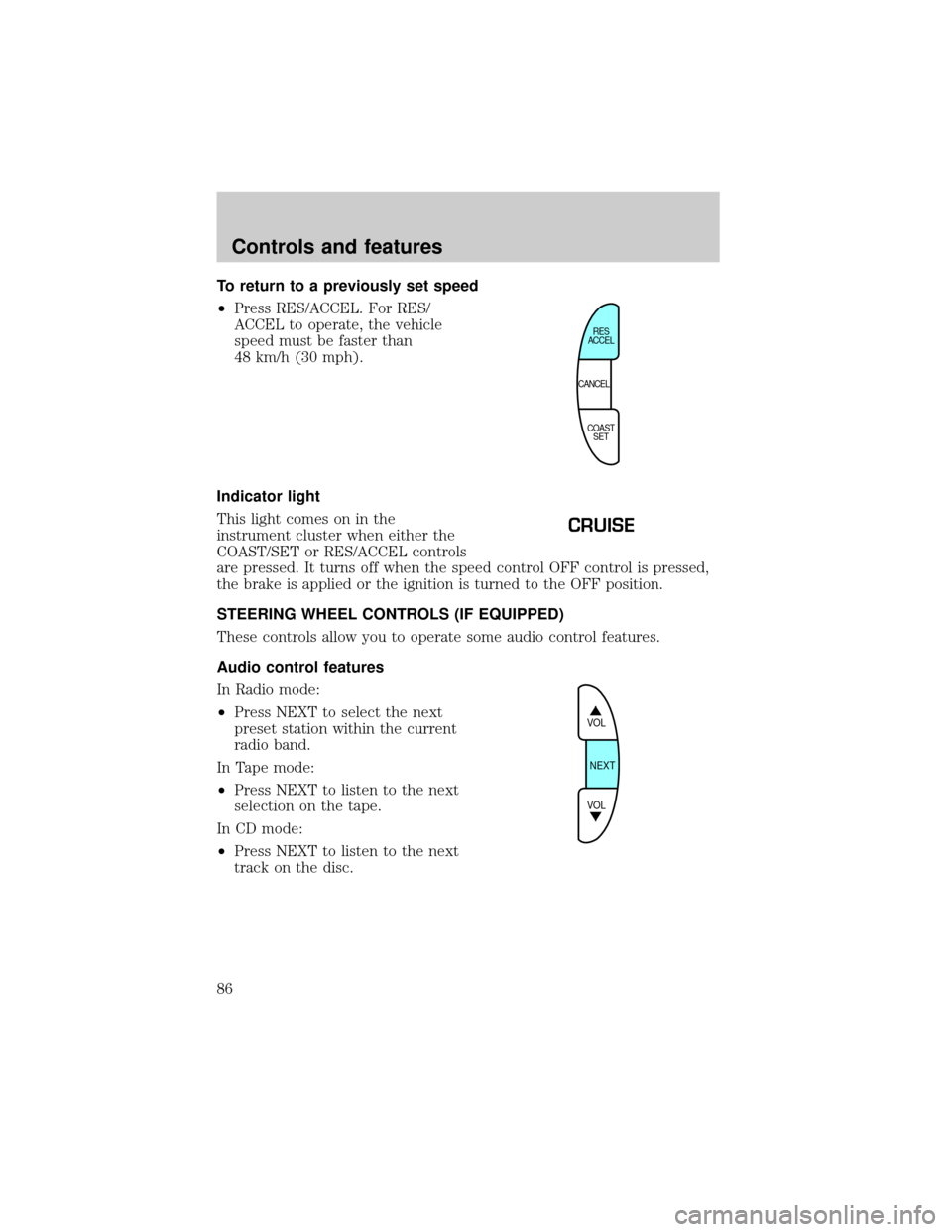
To return to a previously set speed
²Press RES/ACCEL. For RES/
ACCEL to operate, the vehicle
speed must be faster than
48 km/h (30 mph).
Indicator light
This light comes on in the
instrument cluster when either the
COAST/SET or RES/ACCEL controls
are pressed. It turns off when the speed control OFF control is pressed,
the brake is applied or the ignition is turned to the OFF position.
STEERING WHEEL CONTROLS (IF EQUIPPED)
These controls allow you to operate some audio control features.
Audio control features
In Radio mode:
²Press NEXT to select the next
preset station within the current
radio band.
In Tape mode:
²Press NEXT to listen to the next
selection on the tape.
In CD mode:
²Press NEXT to listen to the next
track on the disc.
CANCELRES
ACCEL
COAST
SET
CRUISE
VOL
NEXT
VOL
Controls and features
86
Page 157 of 256

Overdrive Ð column mounted gearshift with O/D off switch
The Overdrive position with the O/D
OFF switchnotdepressed is the
normal driving position for this
automatic overdrive transaxle. When your vehicle cruises at a constant
speed for any length of time, this fourth gear will increase your fuel
economy.
Overdrive may not be appropriate
for certain terrains. If the transaxle
shifts back and forth between third
and fourth gears while you are
driving hilly roads or if your vehicle
requires additional power for climbing hills, press the O/D OFF switch.
Each time the vehicle is started, the transaxle will automatically return
to normal overdrive mode.
If your vehicle is on an extremely slippery surface, the Transaxle Control
Module may receive a signal indicating a rapid increase or decrease in
wheel speed. When the module detects this condition, it will limit the
transaxle operation to Third and Reverse gears. This reduces tire
slippage and protects the transaxle. The transaxle will operate normally
in Reverse, but will lack power during acceleration in Drive.
If this happens;
1. Stop your vehicle as soon as possible.
2. Turn the ignition off for three seconds.
3. Restart the vehicle.
If the condition still exists, contact your dealer as soon as possible.
If the O/D OFF indicator light is flashing on and off repeatedly when the
vehicle is started or does not come on when the O/D OFF control is
pressed, there may be a transaxle electronic system malfunction. You
should contact your dealer as soon as possible or damage to the
transaxle could occur.
P RND21
OVERDRIVE
OFF/ON
Driving
157
Page 220 of 256
![Mercury Villager 2000 Owners Manuals Conditions
²Heavily loading a vehicle or towing a trailer may reduce fuel economy
at any speed.
²Carrying unnecessary weight may reduce fuel economy (approximately
0.4 km/L [1 mpg] is lost for every Mercury Villager 2000 Owners Manuals Conditions
²Heavily loading a vehicle or towing a trailer may reduce fuel economy
at any speed.
²Carrying unnecessary weight may reduce fuel economy (approximately
0.4 km/L [1 mpg] is lost for every](/img/33/11171/w960_11171-219.png)
Conditions
²Heavily loading a vehicle or towing a trailer may reduce fuel economy
at any speed.
²Carrying unnecessary weight may reduce fuel economy (approximately
0.4 km/L [1 mpg] is lost for every 180 kg [400 lb] of weight carried).
²Adding certain accessories to your vehicle (for example bug
deflectors, rollbars/light bars, running boards, ski/luggage racks) may
reduce fuel economy.
²Using fuel blended with alcohol may lower fuel economy.
²Fuel economy may decrease with lower temperatures during the first
12±16 km (8±10 miles) of driving.
²Driving on flat terrain offers improved fuel economy as compared to
driving on hilly terrain.
²Transmissions give their best fuel economy when operated in the top
cruise gear and with steady pressure on the gas pedal.
²Close windows for high speed driving.
EPA window sticker
Every new vehicle should have the EPA window sticker. Contact your
dealer if the window sticker is not supplied with your vehicle. The EPA
window sticker should be your guide for the fuel economy comparisons
with other vehicles.
It is important to note the box in the lower left corner of the window
sticker. These numbers represent the Range of L/100 km (MPG)
expected on the vehicle under optimum conditions. Your fuel economy
may vary depending upon the method of operation and conditions.
EMISSION CONTROL SYSTEM
Your vehicle is equipped with various emission control components and a
catalytic converter which will enable your vehicle to comply with
applicable exhaust emission standards. To make sure that the catalytic
converter and other emission control components continue to work
properly:
²Use only the specified fuel listed.
²Avoid running out of fuel.
²Do not turn off the ignition while your vehicle is moving, especially at
high speeds.
Maintenance and care
220
Page 252 of 256

Clock ..................................48,60,71
Console ......................................101
overhead ....................................98
Controls
power seat ...............................113
steering column ........................86
Coolant
checking and adding ..............194
refill capacities .................197,233
specifications ...................234,235
Cruise control
(see Speed control) ....................82
Customer Assistance ................166
Ford accessories for your
vehicle .....................................245
Ford Extended
Service Plan ............................238
Getting assistance outside
the U.S. and Canada ..............244
Getting roadside assistance ...166
Getting the
service you need ....................238
Ordering additional
owner's literature ...................249
The Dispute
Settlement Board ...................241
Utilizing the Mediation/
Arbitration Program ...............244
Defrost
rear window ..............................40
Dipstick
automatic
transmission fluid ...................198
engine oil .................................189
Doors
door ajar warning .......................9
lubricant specifications ..........234
Driving under special
conditions
through water .........................159
Emergencies, roadside
jump-starting ..........................180Emission control system ..........220
Engine ........................................235
check engine/service engine
soon light ..................................11
cleaning ...................................229
coolant .....................................194
idle speed control ...................201
lubrication
specifications ...................234,235
refill capacities ........................233
service points ..........................188
starting after a collision .........167
Engine block heater .................150
Engine oil ..................................189
checking and adding ..............189
dipstick ....................................189
filter, specifications .........191,233
recommendations ...................191
refill capacities ........................233
specifications ...................234,235
Exhaust fumes ..........................150
Floor mats .................................102
Fluid capacities .........................233
Fuel ............................................212
calculating fuel economy .......217
cap ...........................................214
capacity ...................................233
choosing the right fuel ...........215
comparisons with EPA fuel
economy estimates .................220
detergent in fuel .....................216
filling your vehicle
with fuel ....................212,214,217
filter, specifications .........217,233
fuel pump shut-off switch .....167
gauge .........................................16
improving fuel economy ........217
low fuel warning light ..............10
octane rating ....................216,235
quality ......................................216
running out of fuel .................217
Index
252